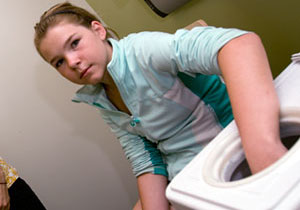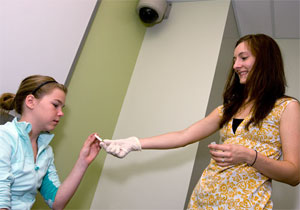 |
| Jessie McLaughlin takes part in the "spit study," by dipping her hand in water at a temperature of 10 C. (Bruce Bottomley Photo) |
As any parent knows, it’s tough to know just how much your kid hurts. Whether they’re in full-blown tears, whimpering or presenting a brave face, it’s hard to gauge their pain. Will a band-aid on the boo-boo do it, or are we bound for the emergency department?
And it’s difficult for them to tell you too. Sometimes they just don’t have the language skills or are simply unable to rate their pain on a scale of 0 to 10. (That can be tough for adults too.)
Which brings us to the “spit study,” a pilot study underway through the Centre for Pediatric Pain Research at the IWK Health Centre. Researcher Kristin Wilby is seeking children between the ages of eight and 12 to take part.
Ms. Wilby, a first-year ¬È∂π¥´√Ω medical student, is taking two samples of the kids‚Äô saliva before and after a ‚Äúcold presser task,‚Äù which basically means plunging a hand in cold water for four minutes.
The idea is find out whether levels of cortisol, a hormone secreted by adrenal glands and found in spit, increase after children take part in the cold presser task. Cortisol, also known as the “stress hormone,” might be an important factor in better understanding which children are at risk for developing chronic pain later in life.
‚ÄúSummer students like Kristin make significant contributions to many research programs at ¬È∂π¥´√Ω. I expect that Kristin‚Äôs research will be an important part of an upcoming grant application that will examine various biopsychosocial factors in the development of chronic pain in children,‚Äù says Christine Chambers, a Canada Research Chair in Pain and Child Health and Associate Professor of Pediatrics and Psychology at ¬È∂π¥´√Ω. Dr. Chambers is also Ms. Wilby's supervisor for the project,¬Ýwhich is being conducted in collaboration with Tara Perrot-Sinal in the Department of Psychology at ¬È∂π¥´√Ω.
“It’s nice to feel you’re contributing something new to science and maybe, down the line, your little study will turn out to be important,” says Ms. Wilby, from St. Stephen’s, N.B.
 |
| Researcher Kristin Wilby gives volunteer Jessie McLaughlin a swab to chew on. (Bruce Bottomley Photo) |
Eleven-year-old Jessie is Ms. Wilby’s first volunteer of the day. She is asked to chew on a sterile cotton swab for 45 seconds—she looks like she’s eating a bun past a best-before date. Her saliva will later be extracted from the swab and examined.
Then, sitting on a chair, she’s asked to dip her hand in a cooler filled to the brim with cold water. She looks nonchalant, even blasé through the four-minute task, even though she’s been told she can stop the task at any time if it proves too uncomfortable.
The water, she explains after extracting a bright-red hand from the cooler, was “not really that cold. I think the water at Crystal Crescent is waaaaayyy colder.”
After 20 minutes, she is again asked to work up a saliva lather over a second cotton swab. Waiting the 20 minutes allows enough time for the hormone to enter the blood stream and then the saliva.
The entire visit takes little more than an hour. “I didn’t mind it,” says Jessie, holding on to her "Junior Scientist" certificate. “Besides, it’s kind of neat to take part in real research.”
If you‚Äôve got a child between the ages of eight and 12 who‚Äôd like to take part, phone the Centre for Pediatric Pain Research at 470-7706 or e-mail Kristin Wilby at kwilby@ymail.com.¬ÝThe research is funded by summer studentships from the IWK Health Centre and the ¬È∂π¥´√Ω Faculty of Medicine.
LINKS: |
